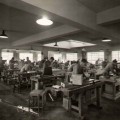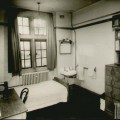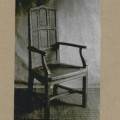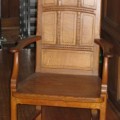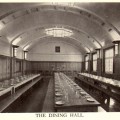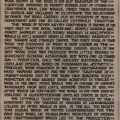Loughborough, the Cotswold Tradition and Peter Waals
22 September 2014
- Peter Waals, from an article in The Limit in 1937
- College handicraft shop c1937
- Waals’ design for a wardrobe c1937
- Student bedroom c1939
- Chair designed by Peter Waals
- Hazlerigg high table carver chair
- Hazlerigg dining hall c1939
- A page from Waals’ memorial book
There has been much interest – locally and nationally – in the National Trust’s 2012 purchase of Stoneywell Cottage in Ulverscroft, Leicestershire, and its opening in the summer of 2014. But do you know of the link between Ernest Gimson – one of the most influential architect-designers of the British Arts and Crafts Movement and the ‘genius’ behind Stoneywell – and the town of Loughborough?
LOUGHBOROUGH, THE COTSWOLD TRADITION & PETER WAALS
The Arts and Crafts movement originated in Britain in the 1880s as a reaction against mass-produced, poor quality goods and a decline in traditional craftsmanship. Inspired by the ideas of John Ruskin and William Morris, its followers aimed to revive both the design of ordinary domestic objects and the standard of craftsmanship used to make them.
At the forefront of the Arts and Crafts movement were Leicester-born architect and designer Ernest Gimson and the Barnsley brothers, Ernest and Sidney. The three established workshops close to each other in the Cotswold countryside, where they revived rural traditions of craftsmanship.
Notable features of the Cotswold Tradition of furniture making were the careful choice of solid wood to make simple, well-proportioned, functional pieces, the use of an open construction with dovetailing or pinned joints, and restrained decoration.
Dutch-born furniture designer and craftsman Peter Waals was foreman of Gimson’s workshops for many years and was a close friend of the Barnsleys. He set up his own workshop at Chalford after Gimson’s death in 1919.
Later, Peter Waals introduced the Cotswold Tradition to Loughborough College, the forerunner of the University, when he was appointed consultant in cabinet making and design in 1934.
Waals designed furniture for Rutland and Hazlerigg, the newly erected Halls of Residence opened on the College’s playing fields site in 1937. He also designed tables, chairs and bookcases for the College library in its buildings in town.
The furniture itself was made by students training at the College to be handicraft teachers. In addition to their individual pieces, they made the bedroom, dining hall and library furniture designed by Peter Waals. Some is still in use in the University today, notably the high table and chairs constructed for the dining room of Hazlerigg Hall.
Hazlerigg is now an administrative building but the old dining room has retained its original tables, chairs and panelling and has become the University’s Council Chamber. Most of the chairs have the name of the student who made them and the year they were made carved into the frame under the seat.
Peter Waals died in 1937 but was succeeded as consultant in cabinet making and design by another craftsman directly linked to the Cotswold Tradition. Edward Barnsley, son of Sidney, taught at Loughborough until 1965, developing what Waals had begun and instructing and influencing new generations of handicraft teachers in the Cotswold Tradition of furniture making.
Jenny Clark, Loughborough University Archives
There are two original drawings for College furniture, signed by Peter Waals, in the University Archives. The attached picture shows the introductory page of a leather bound, hand-crafted volume of photographs which commemorates his work.
A representation of a student’s bedroom from the 1950s, set out as it would have been with furniture of the Cotswold tradition, can currently be seen on display at Charnwood Museum, Granby Street, Loughborough. (September 2014.)
Discover more:
Read an article by Loughborough University academic Ruth Kinna about William Morris’s ideas of Art, Work and Leisure.
Watch a lecture on craftsmanship by Professor Richard Sennett of New York University and London School of Economics.
Read a National Trust article on Ernest Gimson – ‘a very English genius’ – and another on Peter Waals by Leicester Arts & Museums Service.

